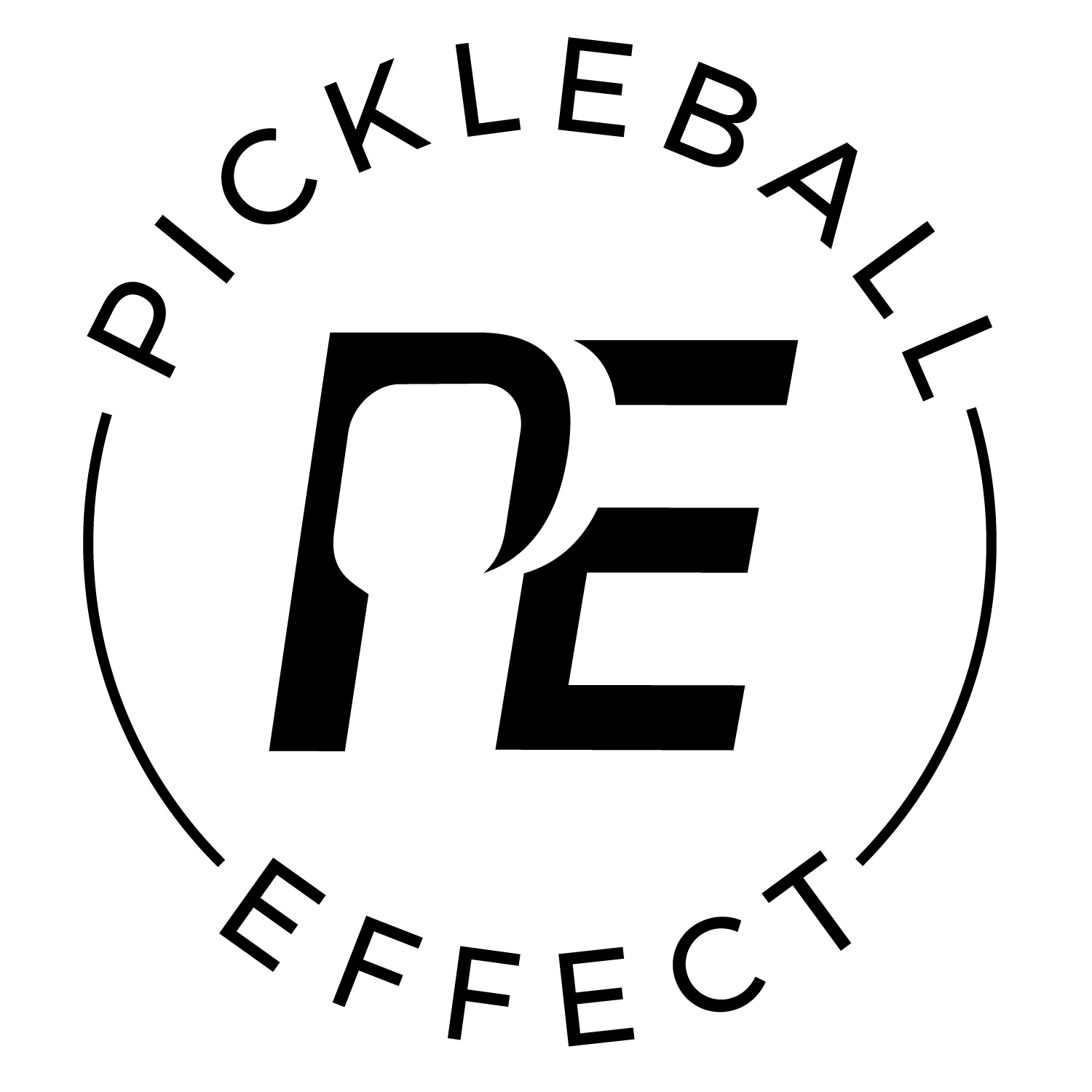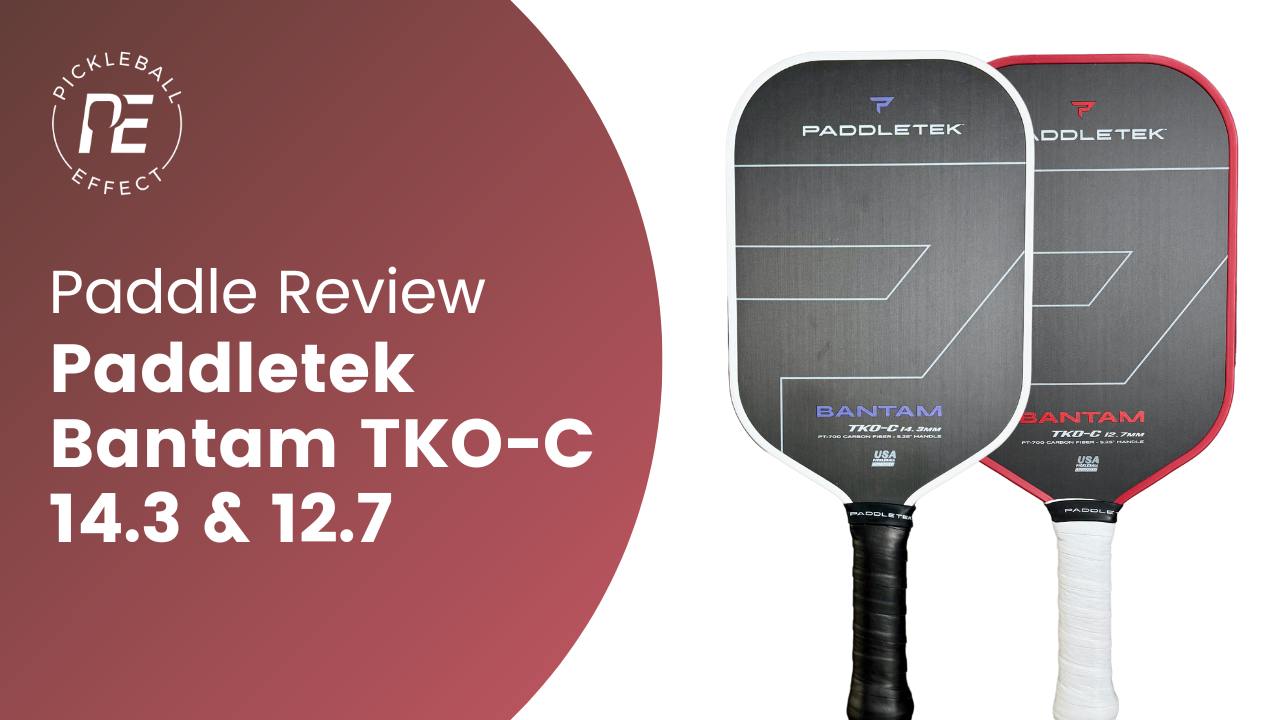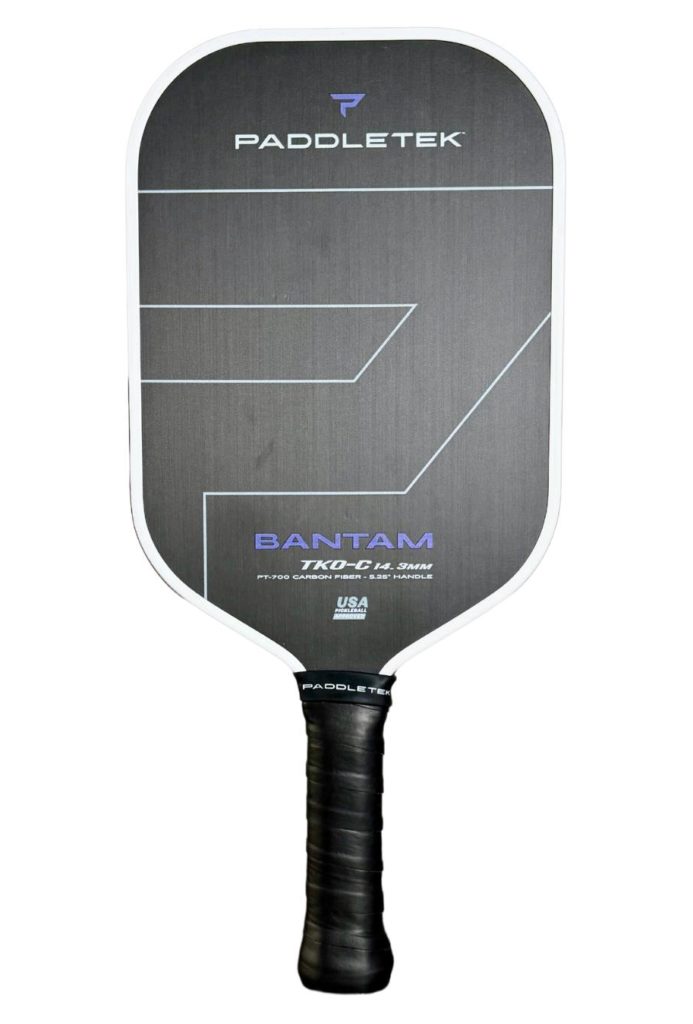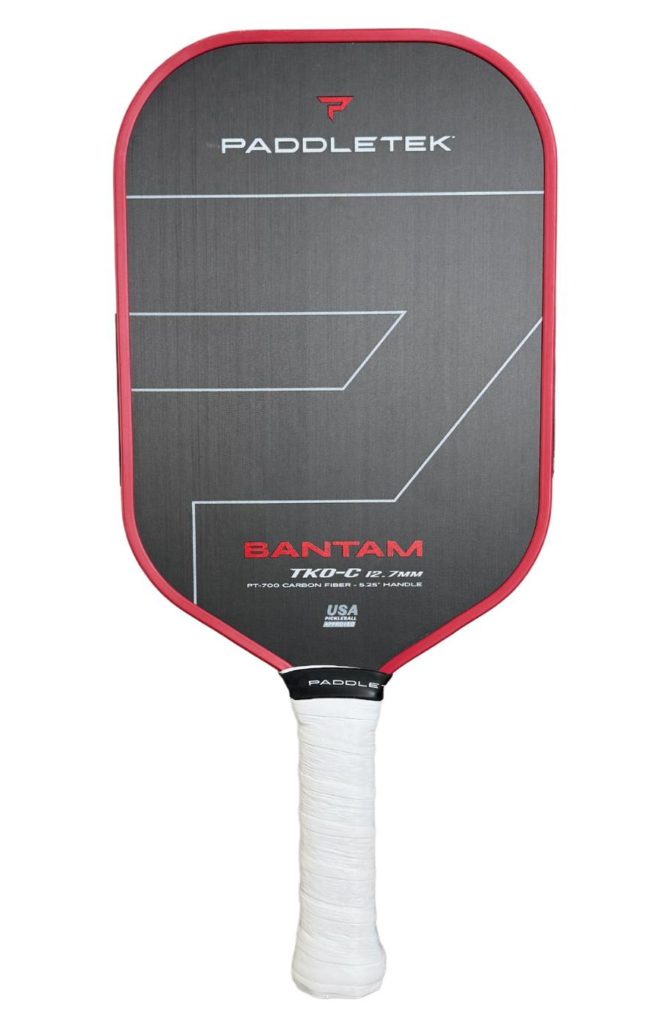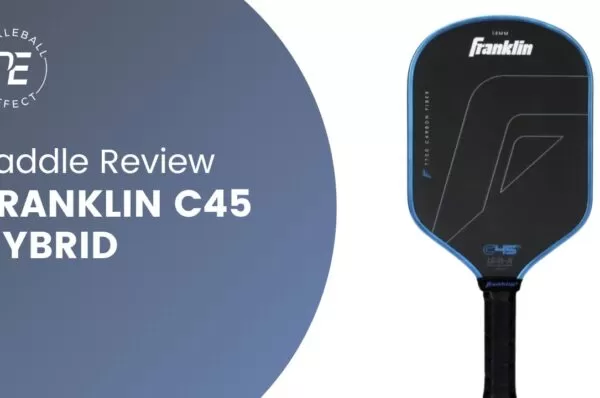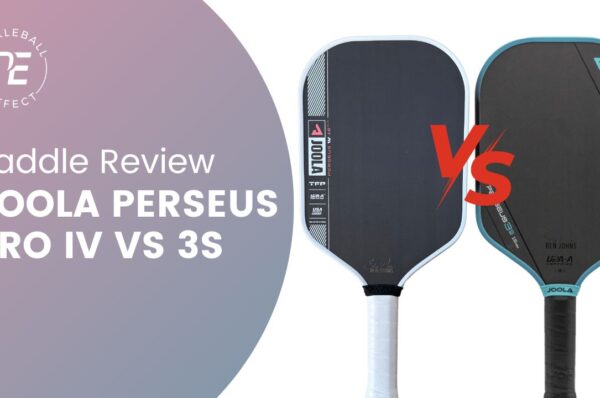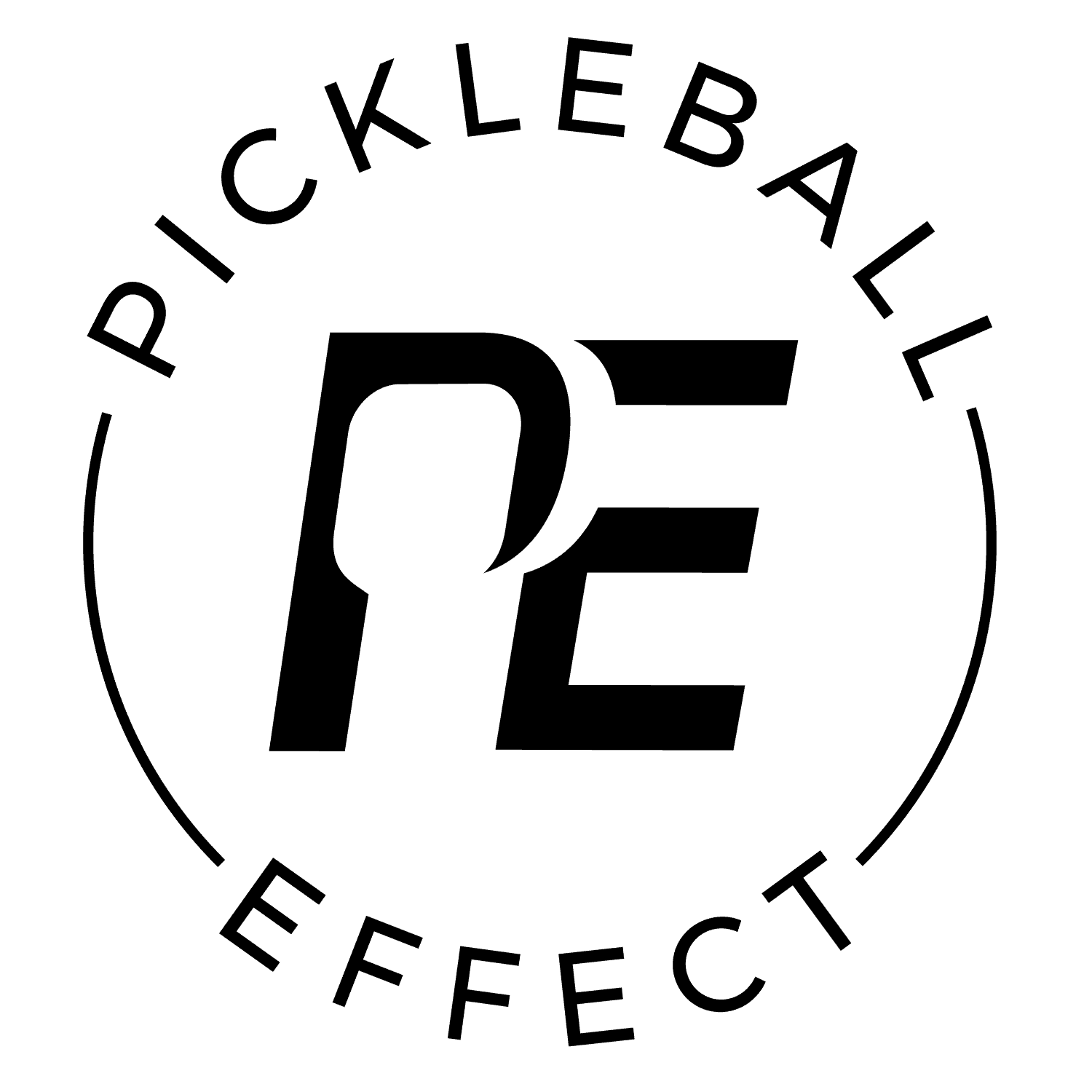I haven’t been particularly impressed with Paddletek paddles over the years but they’ve finally introduced a couple of paddles that I can really get behind. Their new big power paddles, the Bantam TKO-C 12.7mm and TKO-C 14.3mm, are good and are becoming even more appealing given the recent durability issues faced by gen 3/foam paddles.
These paddles were developed in collaboration with professional player Christian Alshon. They feature elongated designs with 5.3″ handles, although they also offer longer 5.75″ handle versions known as TKO-CX. In this review, I primarily played with the 5.3″ handle versions and will concentrate my evaluation on those.
After drilling and playing with the paddles for two weeks, here are my thoughts on their performance.
Table of Contents
Paddle Technology & Stats
When examining the construction of these Paddletek paddles, there is nothing particularly innovative or flashy about them. In fact, it’s quite the opposite. They do not utilize thermoforming, foam-injected sidewalls, or foam integrated into the core, which are all the latest advancements in paddle technology. However, the power delivered by these paddles is only slightly less than the high-powered paddles on the market that do incorporate these technologies, such as the JOOLA Gen 3 paddles, Gearbox Pro Power paddles, and the Vatic Pro Oni paddles. But, this is part of the attraction to these paddles. You get the big power without the durability issues that have been plaguing thermoformed and foam core paddles.
Paddletek claims to use a unique polymer core material and a blend of carbon fiber and fiberglass in the facing layers to achieve the desired power. Although this approach may seem basic, it is proving to be effective. Another puzzling aspect of these paddles is that despite the absence of technologies like foam-injected sidewalls that enhance stability and forgiveness, these paddles surprisingly exhibit good stability, considering their thickness and lack of such technology. It’s unclear why, but these paddles offer more forgiveness than comparable options with similar thicknesses.
Lastly, one of the reasons Paddletek paddles failed to appeal to me in the past was due to their absence of raw or peel ply type facing materials for generating spin, their bulky and exposed polymer handles, and the rounded bubble end cap they previously utilized. However, they have addressed all of these concerns by introducing a uniform, octagonal handle and a regular tennis-style end cap, and adding raw carbon fiber to all their paddles resulting in a much more comfortable feel and higher spin potential.
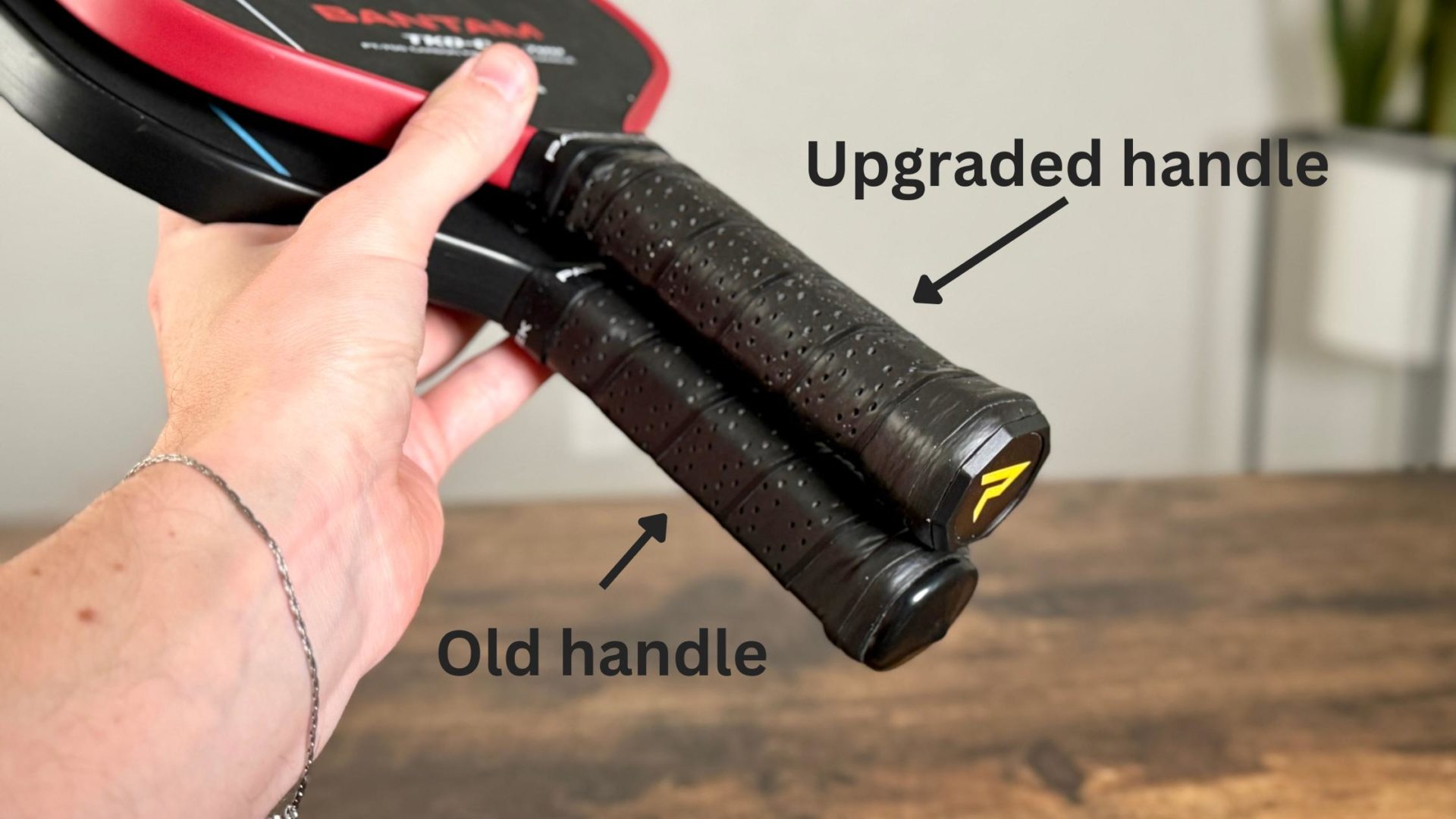
Bantam TKO-C 14.3mm
- Static Weight: 7.9 oz avg
- Swingweight: 115-117 (moderate)
- Twistweight: 6.4-6.5 (moderate)
- Spin RPMs: 1910 (high)
- Length x Width: 16.5″ x 7.5″ (elongated)
- Face: Raw carbon fiber
- Grip Circumference: 4.25″
- Handle Length: 5.3″
- Core: 14.3 Bantam Polypropylene Honeycomb
- Special Features: Made in the US
- Paddle Type: Power
- Price: $249.99 (save $25 with link below)
- Warranty: Limited lifetime
(Click the link above to apply Pickleball Central discounts automatically)
Bantam TKO-C 12.7mm
- Static Weight: 7.9 oz avg
- Swingweight: 114-116 (moderate)
- Twistweight: 6.6-6.8 (high)
- Spin RPMs: 1903 (high)
- Length x Width: 16.5″ x 7.5″ (elongated)
- Face: Raw carbon fiber
- Grip Circumference: 4.25″
- Handle Length: 5.3″
- Core: 12.7 Bantam Polypropylene Honeycomb
- Special Features: Made in the US
- Paddle Type: Power
- Price: $249.99 (save $25 with link below)
- Warranty: Limited lifetime
(Click the link above to apply Pickleball Central discounts automatically)
Performance Summary
Durability
I want to highlight the enhanced durability of these paddles, as it is particularly appealing given the recent discussions about durability issues with the new technology used in Gen 3 paddles that incorporate foam in the cores for increased power.
In the past year or so, paddle technology has seen advancements such as thermoforming and foam integration in the cores. While Gen 2 and Gen 3 paddles utilizing these technologies perform well in terms of power and responsiveness, they are prone to durability flaws such as core crush and face disbonding, which can cause them to fail and fall out of specifications. Despite improvements in thermoformed paddle durability, these issues are resurfacing with the emergence of Gen 3 style paddles. These paddles can break down within a month to eight months of use, leading to frequent warranty claims and concerns.
In contrast, the simplicity of the technology in these Paddletek paddles inherently makes them more durable and significantly reduces the risk of core crush and face disbonding because they don’t use heat in the manufacturing process like thermoforming methods. Moreover, since these paddles achieve a similar level of power as the Gen 3 paddles, they become even more attractive options for players seeking power but don’t want to deal with durability issues.
Power and Pop
The power and pop level of both thicknesses are big and just below the measurements I’m getting from Gen 3 type paddles that use foam in the core like JOOLA and Gearbox paddles. While some paddles have high pop and low power or vice versa, these paddles measure high in both areas.
As pickleball play styles continue to involve more drives and attacks, having power in your paddle can help you fight fire with fire. For me, this means it’s easier to hit bigger serve returns and counter punch drives more effectively by getting the ball back on them quickly and deeper into the court which slows down your opponents and reduces their effectiveness in using the power game.
When the ball is coming faster at you, you have less time to react and respond which means you have less time to move your paddle to generate power. But when your paddle can generate the power and pop for you, you don’t need a bigger swing to get the speed you need to do damage to your opponents.
The pop level on the 12.7mm is particularly impressive. The ball really jumps off on counters and when you have a chance to put the ball away. The pop level on the 14.3 is also good, but you could notice the difference between the two when playing. The 12.7 had more. The paddles both have lighter static weights and lower swingweights for elongated paddles and move well at the net. This gave them a nice combo of maneuverability and pop which was great for counters and hand battles.
I noticed that the bounce off the face of these paddles was more consistent compared to the Gen 3 style paddles from JOOLA and Gearbox. This consistency made the paddles more predictable, allowing me to swing bigger and with greater confidence because I knew what to expect. In contrast, with foam-style paddles, there were instances where a few balls throughout each game would unpredictably gain extra speed and float long, high, or wide when attacking.
The power was impressive right out of the box, and I didn’t really notice a break-in period, which is typically when players experience an increase in power as the paddle gets used. The power was strong from the beginning and appeared to remain consistent with continued use. Additionally, I had previously used the term “exponential power” to describe how the JOOLA paddles delivered three times the power with only double the effort, but this was not the case here. Instead, the effort and resulting power were proportional.
Feel and Control
There are a couple of pros and cons in this area for the paddle. Pros are that the paddle has a more consistent bounce off the face than the big powered Gearbox and JOOLA paddles which makes it easier to reset the ball and control the pace of play. The JOOLA paddles in particular can be less predictable due to the trampoline effect they have which can cause pop ups here and there when you’re trying to slow the ball down. This was a big plus for me, I definitely was more consistent with my soft game across the board with these over the JOOLAs.
For cons, they have a less intuitive feel to them. The 12.7 has a firmer and stiffer feel to it that’s similar to a 14mm thermoformed paddle but a little denser or heavier feel to it. It offers good feedback and if you like the feel of firmer or stiffer 14mm paddles from other brands then you’ll like the feel of the 12.7mm over the 14.3mm option. The 14.3mm has its own feel that’s tough to pin down because it doesn’t compare well to other paddles out there but the best way I can describe it is that it has that stiffer, crisp feel of a 16mm thermoformed paddle but more hollow. The 14.3 certainly feels softer in comparison to the 12.7 and overtime it started to feel plush to me though the 12.7 always kept the same firmer feel.
The 14.3 paddle proved to be easier to control and resulted in fewer errors overall due to its increased forgiveness compared to the 12.7 paddle. However, it’s important to note that both of these paddles fall under the category of high-power paddles, requiring more skill and effort to control effectively.
Sweet Spot and Forgiveness
The sweet spots on these paddles out performed what you would expect by just looking at how thick they are. The 14.3 was more forgiving and stable compared to other 14mm paddles though not quite as good as the average forgiveness level of a thicker, 16mm paddle. While the 12.7mm had the forgiveness level of a good 14mm paddle. This surprised me for a couple of reasons. 1) The paddles have light static weights which usually correlate with less stability, and 2) the paddles don’t have any edge foam or anything so there’s no specific tech that’s making them more stable. It must have something to do with the different core material they are using and the way the weight is distributed across the paddle. Whatever is doing it, it’s working and I liked this part about the paddles.
Spin
Paddletek finally gave in and rolled out raw carbon fiber surfaces across their paddle lines. For whatever reason they haven’t done this until now and their paddles produce much more spin as a result. My spin tests were averaging in the lower 1900s for RPMs which is a good result and will give you everything you need though they don’t top the charts for spin.
Picking Between the TKO-C 14.3mm and TKO-C 12.7mm
Both of these paddles are viable options to consider if you’re in search of a paddle with big power. If you typically play with a 16mm paddle and are drawn to the concept of these paddles, I would recommend the 14.3mm option. On the other hand, if you usually play with a 14mm paddle and are interested in these paddles, I suggest the 12.7mm option. The 14.3mm paddle plays more similarly to a 16mm paddle while the 12.7mm paddle is more similar to a 14mm paddle from other brands.
Other Considerations
Both of these paddles produce a louder sound, which is reminiscent of the Gen 3 JOOLA paddles. If this is a concern for you, particularly if you primarily play in neighborhood courts, then that increased noise may not be well-received by the surrounding houses.
TKO-CX (5.75 inch handles) VS TKO-C (5.3 inch handles)

Paddletek offers these paddles with an extra elongated handle at 5.75” with their TKO-CX options. The TKO-CX 12.7mm is the version that Christian Alshon plays with. I have the CX models and played briefly with them. They obviously have the longer handle and then they do feel a little heavier and more sluggish in comparison to the 5.3” handles. The CX 12.7 has a swingweight around 118 while the CX 14.3 has a swingweight around 122. The higher swingweights did add even more power to the paddle though I couldn’t tell a different stability wise between the CX and C models.
I dink and counter with two hands on my paddle regularly and didn’t find the 5.3” handle length to be too short for me so I personally preferred the 5.3” handle version since it was lighter and still felt comfortable for my two handed stuff. However, if you prefer extra long handles or prefer heavier paddles then the CX models would be the way to go.
My Recommendation
These are my favorite high-powered paddles that I’ve played with so far. Their combination of lighter weight, impressive power, good spin, and good stability, along with their superior durability compared to competitors in the high-power paddle category, makes them highly appealing. The main competitors for these paddles are the JOOLA Gen 3 paddles and the Gearbox Pro Power paddles. I noticed that these paddles had a more consistent bounce, making them easier to control compared to the JOOLA paddles. Additionally, I appreciated their lightweight design and forgiving nature, which set them apart from the Gearbox Pro Power paddles.
If you’re in the market for a high power paddle then I think the decision is primarily between these and the JOOLAs. Go with these if you want a little more control and go with the JOOLAs if you want as much power as you can get. The JOOLAs also have more shape options which is nice too so if Paddletek doesn’t have the ideal paddle shape for you then JOOLA probably does.
(Click the link above to apply Pickleball Central discounts automatically)
What About the Paddletek Tempest Paddles?

I also played withe Paddletek’s new Tempest series which is supposed to be their control type paddles. I wasn’t as big on these as I was with their Bantam TKO paddles and wanted to share my thoughts on these as well.
Specs & design: The Pro-C is their standard shape with a slightly longer 5.25″ handle while the TKO-C is elongated and has a 5.5″ handle though it’s listed at 5.25 on Paddletek’s website. These are not thermoformed and do not have foam injected in the perimeter. They are a gen 1 style, cold pressed paddle. They utilized a raw carbon surface which is an upgrade from the previous tempest series. Finally, it has a different polymer type core material than their power oriented Bantam series that’s supposed to be more control oriented. The Pro-C model has a swingweight of 109 and twistweight of 6.98 while the TKO-C model has a swingweight of 120 and a twistweight of 6.43.
Thoughts: The Tempest models are advertised as control paddles but they actually have enough power and pop to pull them into the all-court category. They have the power and pop level of your typical 16mm thermoformed paddle but not the same level of forgiveness since they are thinner at 14.3. The spin on these was just so so for some reason and my spin tests weren’t as good as what I got for the Bantam series. They did have a nice, softer feel to them compared to thermoformed paddles though, which was a plus for these. However, when you consider the value factor, these are more expensive at $210 and weren’t as good on the control side vs other good control paddles and weren’t as good as your typical 16mm thermoformed paddle in the all-court category so I don’t feel like the value is there. They are made in the US though and do have a good limited lifetime warranty which is nice.
Recommendation: If you’re looking for a control paddle then this isn’t that, it has too much power and pop for that and I don’t see myself recommending these too often in the all-court category either and think paddles like the Six Zero Double Black Diamond or the Vatic Pro V7 fit the bill there better.
(Click the link above to apply Pickleball Central discounts automatically)
Braydon competes at the 5.0 level and plays in 5-10 tournaments a year. He plays/drills 3 to 4 times a week and would play more if time allowed it.

Paddle Terms Glossary
We’ve categorized paddles into three categories. Control, All-Court, and Power. Paddle categories are determined by Braydon after he hits or reviews the paddle.
- Control paddles offer a softer feel and better absorbs pace off the ball but doesn’t give you as much power.
- All-Court paddles give you a blend of power and control and does well at everything though it doesn’t excel at anything.
- Power paddles often have a firmer feel and will return more power but are harder to control.
A paddle’s weight represents the inherent mass of the paddle as measured on a scale. However, relying solely on this static weight measurement can be misleading when assessing the true perceived heaviness of the paddle. Even if two paddles both clock in at 8 oz, their actual heft in your hand can markedly differ due to variations in weight distribution within the paddle. This is why the static weight should be considered with the swingweight of the paddle. See the definition of swingweight below.
The weight value listed in the database corresponds to the paddle’s weight that I used to gather the swingweight and twistweight measurement. It’s possible that if your paddle has a different static weight than then the swingweight and twistweight may be slightly different.
There are three primary shapes a paddle can have which consists of the length and width of the paddle. These three shapes are:
- Elongated: The dimensions for an elongated paddle are 16.5″ x 7.5″.
- Standard: A standard shaped paddle has dimensions of 16″ x 8″.
- Hybrid: A hybrid shaped paddle falls somewhere in between the standard and elongated shapes, with approximate dimensions of 16.25″ x 7.5″-7.7″.
Then there are two less common shapes you’ll see. These are:
- Extra-Elongated: This shape is 17″ x 7″
- Widebody: This any paddle shorter than 16″ long.
When considering the advantages and trade-offs of paddle shapes, it’s important to understand the characteristics of each shape.
- Elongated Paddle: An elongated paddle offers increased reach, spin, and power. However, this additional reach comes at the expense of forgiveness, particularly from side-to-side.
- Standard Paddle: In contrast, a standard-shaped paddle provides less reach and a little less power & spin but offers greater overall forgiveness. This means that while you may not have the same extended reach as an elongated paddle, you gain better control and stability.
- Hybrid Paddle: The hybrid shape serves as a middle ground between the elongated and standard shapes. It provides a balance between reach and forgiveness, offering players a versatile option that combines aspects of both shapes.
It’s interesting to note that advanced players often prefer elongated shapes. On the other hand, players at lower skill levels typically opt for the extra forgiveness offered by standard shaped paddles.
Ultimately, the choice of paddle shape depends on an individual’s playing style, preferences, and skill level. Whether your focus is on reach or forgiveness, understanding the unique benefits and trade-offs of each shape can assist you in selecting the paddle that best suits your game.
Swingweight is a measure of the paddle’s resistance to swinging about the end of the handle. The higher the swingweight number the heavier it will feel in your hands. A higher swingweight has more power but is harder to swing, lower swingweight is easier to swing but has less power. Sometimes a faster swing with a lower swingweight can make up for power lost in swingweight. The price paid for that is greater impact shock. Stock swingweights will vary between 100 – 140.
Twistweight is the resistance to rotating around the long axis through the middle of the paddle from butt to tip. The higher the twistweight the more resistance the paddle has to rotating on off center hits. This measurement is closely related to the amount of forgiveness or the size of the sweet spot of the paddle. A higher twistweight indicates a bigger sweet spot. Twistweight numbers range from 5 – 8.
Measuring the revolutions per minute (RPMs) off of a serve you get a number that shows the spin potential of a paddle. Using these RPM measurements I’ve created five buckets that a paddle will fall into indicating its overall spin potential. The five buckets are:
1900 or Higher = Very High
1700 – 1900 = High
1500 – 1700 = Medium
1300 – 1500 = Low
1300 or less = Very Low
You can tell a big difference in the amount of spin a paddle generates when you compare a Very High paddle to a low paddle. But the gains from Medium to High to Very High are marginal. We’ve found that having at least a medium rating is often enough if you’re looking for a good spin paddle. However, if you’re a big hitter then you will benefit more from a high spin paddle to help you keep the ball in play more often.
The power level of a paddle is shown in miles per hour (MPH) after taking ten measurements with a speed gun of hitting a serve as hard as I can. This measurement gives you an idea of how hard you can hit the ball when given the chance to take a full swing. So shots like serves, drives and overheads. The higher the MPH reading the more power you can generate with the paddle.
I also show the percentile ranking of the measurement to give you an idea of how it stacks up against the rest of the paddles in my database.
The pop level of a paddle is shown in miles per hour (MPH) after taking the average of ten speed gun measurements of hitting a punch volley as hard as I can. This measurement gives you an idea of how hard you can hit the ball on shorter swings and gives you an idea of how quickly a ball comes off the face when you apply less force on the ball. So shots volleys, dinks, counters, and resets are all affected by the pop measurement. The higher the pop measurement the stronger your counters will be but it takes more skill to keep the ball from floating or popping up on you when resetting a hard hit ball or when dinking.
I also show the percentile ranking of the measurement to give you an idea of how it stacks up against the rest of the paddles in my database.
This is the term being used to describe latest push in paddle technology that’s emerged in 2024. Any high powered paddle that uses some sort of foam in the design of the core of the paddle would be considered a Gen 3 paddle.
This is the term used to describe paddles made with thermoforming. Thermoforming means the paddle was put together using heat to add a carbon seam around the perimeter of the paddle that connects the two facing layers. This technology is often accompanied with a layer foam that is injected into the perimeter of the paddle to improve the feel and sweet spot of the paddle. This technology emerged in 2023 and is the most popular method used to build paddles though the method is susceptible to durability issues because of the heat used when creating the paddle.
